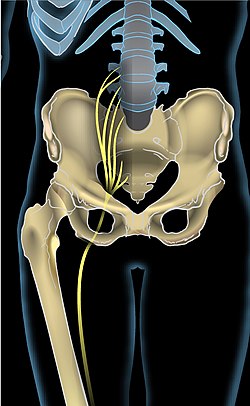| Sciatic nerve | |
|---|---|
 Right gluteal region, showing surface markings for arteries and sciatic nerve | |
| Details | |
| Pronunciation | /saɪˈætɪk/ |
| From | Lumbar and sacral plexus (L4-S3) |
| To | Tibial and common fibular nerve |
| Innervates | Lateral rotator group (except piriformis and quadratus femoris) and the posterior compartment of thigh |
| Identifiers | |
| Latin | nervus ischiadicus |
| MeSH | D012584 |
| TA98 | A14.2.07.046 |
| TA2 | 6569 |
| FMA | 19034 |
| Anatomical terms of neuroanatomy | |
The sciatic nerve, also called the ischiadic nerve, is a large nerve in humans and other vertebrate animals. It is the largest branch of the sacral plexus and runs alongside the hip joint and down the lower limb. It is the longest and widest single nerve in the human body, going from the top of the leg to the foot on the posterior aspect. The sciatic nerve has no cutaneous branches for the thigh. This nerve provides the connection to the nervous system for the skin of the lateral leg and the whole foot, the muscles of the back of the thigh, and those of the leg and foot. It is derived from spinal nerves L4 to S3. It contains fibres from both the anterior and posterior divisions of the lumbosacral plexus.